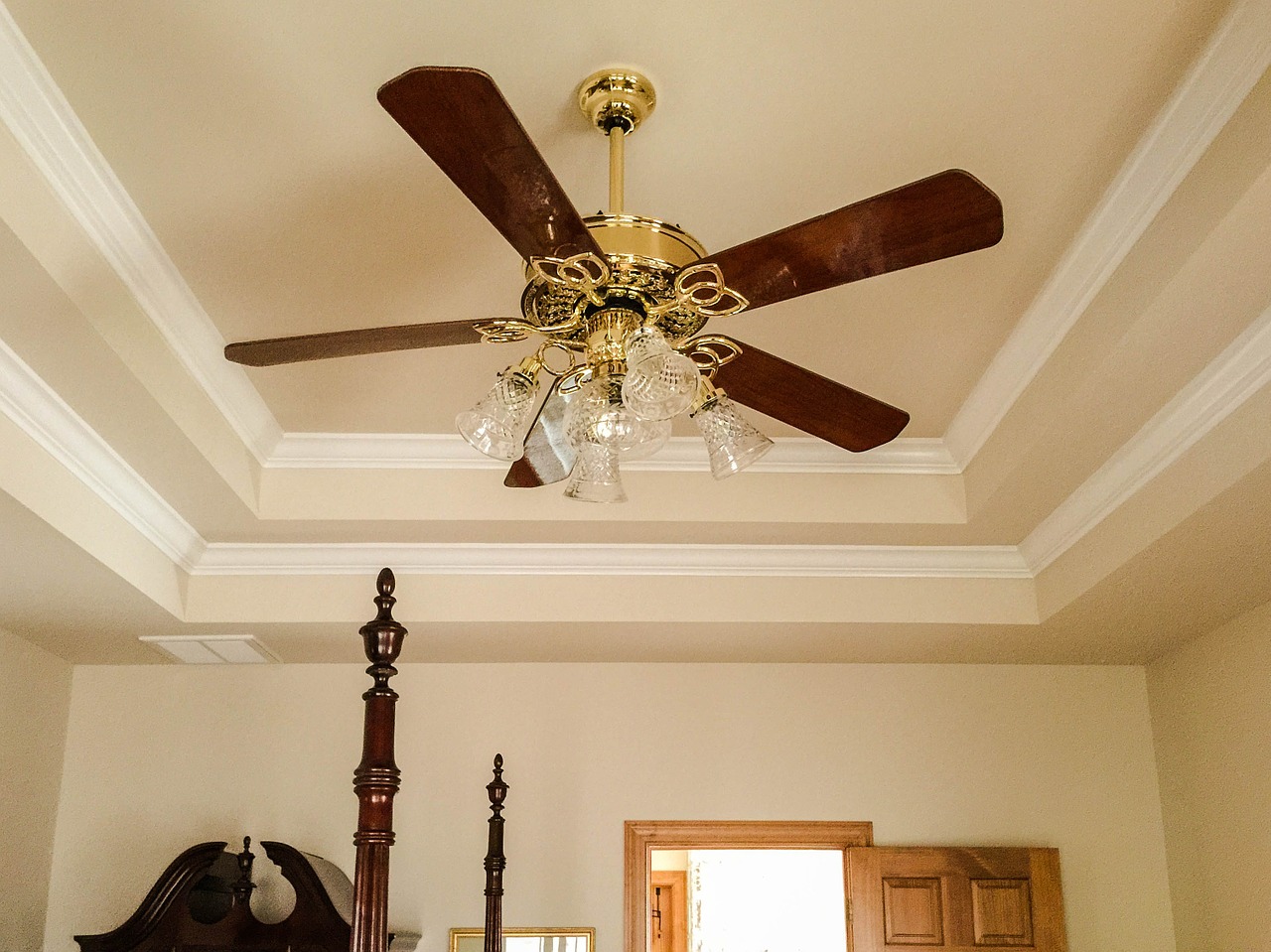If you’re wondering how much is crown molding then you have come to the right place. After all, there’s no doubt that crown molding can provide an elegant feel to a room. It is the crowning glory of interior design that adds architectural character and stunning visual separation between the walls and the celing.
The costs involved around crown molding, are in three areas;
- Cost of the total amount of crown molding material you require for the space (eg polyurethane, wood, polystyrene, plaster, mdf, vinyl etc)
- Cost of the tools required to install the molding (miter saw, coping saw, finish nailer, sander, paint)
- Labor costs of installation (if paying for services)[lwptoc title=”Quick links to Contents on this page” toggle=”1″ labelShow=”show” labelHide=”hide” hideItems=”1″]
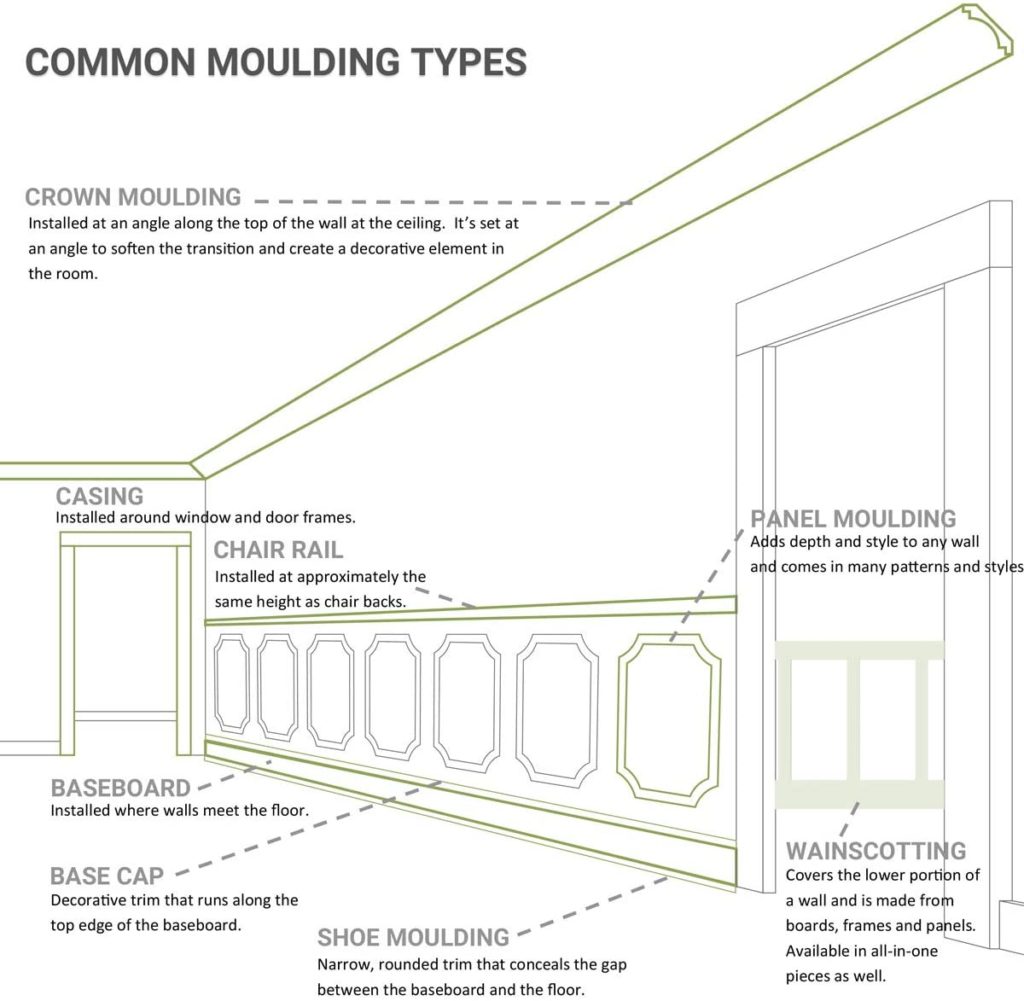
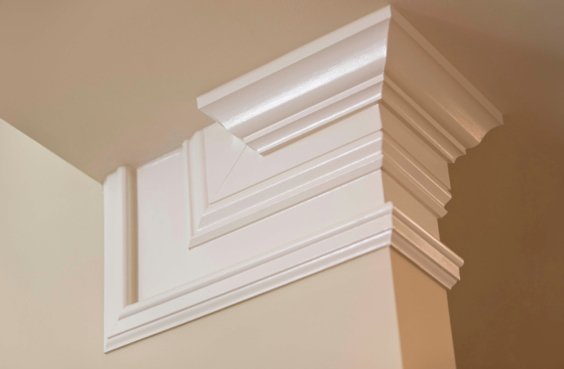 The total amount that crown molding will cost you will really depend on your specific requirements including; the look your after, the difficulty of the job in terms of space and preparation required and the tools you own or need to purchase.
The total amount that crown molding will cost you will really depend on your specific requirements including; the look your after, the difficulty of the job in terms of space and preparation required and the tools you own or need to purchase.
Crown molding doesn’t necessarily have to be an overly expensive exercise with a lot of DIYers tackling the job themselves. There are certainly a lot of ‘how to guides’ available and we have a post on measuring and cutting crown molding to assist with this process.
For our personal experiences as carpenters who have installed loads of crown molding over the years, we note that the average cost to install crown molding ranges between $7 to $16 per linear foot (depending on the material and labor costs). Therefore, an average living room of 15’ x 14’, crown molding would cost $464 to $1102, while a typical 10×10 kitchen costs $210 to $570 for labor and installation.
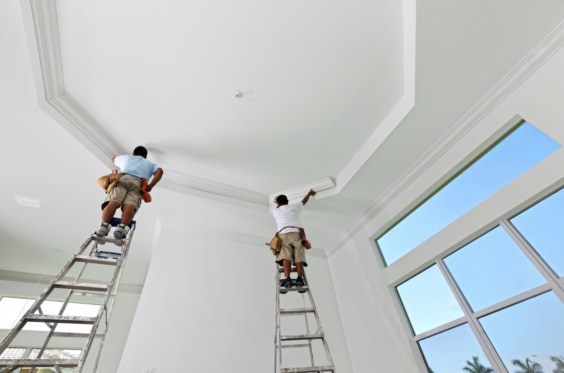
If you were looking to install crown molding in an entire home, you can expect to pay anywhere between $2000 and $4000 on conservative estimates.
Of course the pricing can vary significantly depending on the material of the molding and this can effect labor costs. The good news is that the majority of the costs for crown molding is the labor. So if you can install it yourself, you’ll be saving a small fortune.
The other thing to consider (if you’re going to pay for installation) is that the type of material you use, will also effect labor costs. For example, when I install wood crown molding, this takes me longer as it needs precise angle cuts so the set up, site work and clean up takes longer than working with other materials. It can take anywhere from 10 to 25 minutes to install each foot of crown molding – depending on what’s required (such as hammering, and torching for metalwork or glue polystyrene foam and or mitering and sawing wood).
Cost of Crown Molding Per Linear Foot
On average, crown molding costs between $1 to $4 per linear foot, for a 5” area. Solid wood molding costs the most in terms of material and ranges between $1 to $4 per linear foot. Other materials such as vinyl, PVC, foam or MDF, typically cost between $1 and $2 per foot. Some exotic woods can be quite expensive and I have laid one that cost $45 per linear foot.
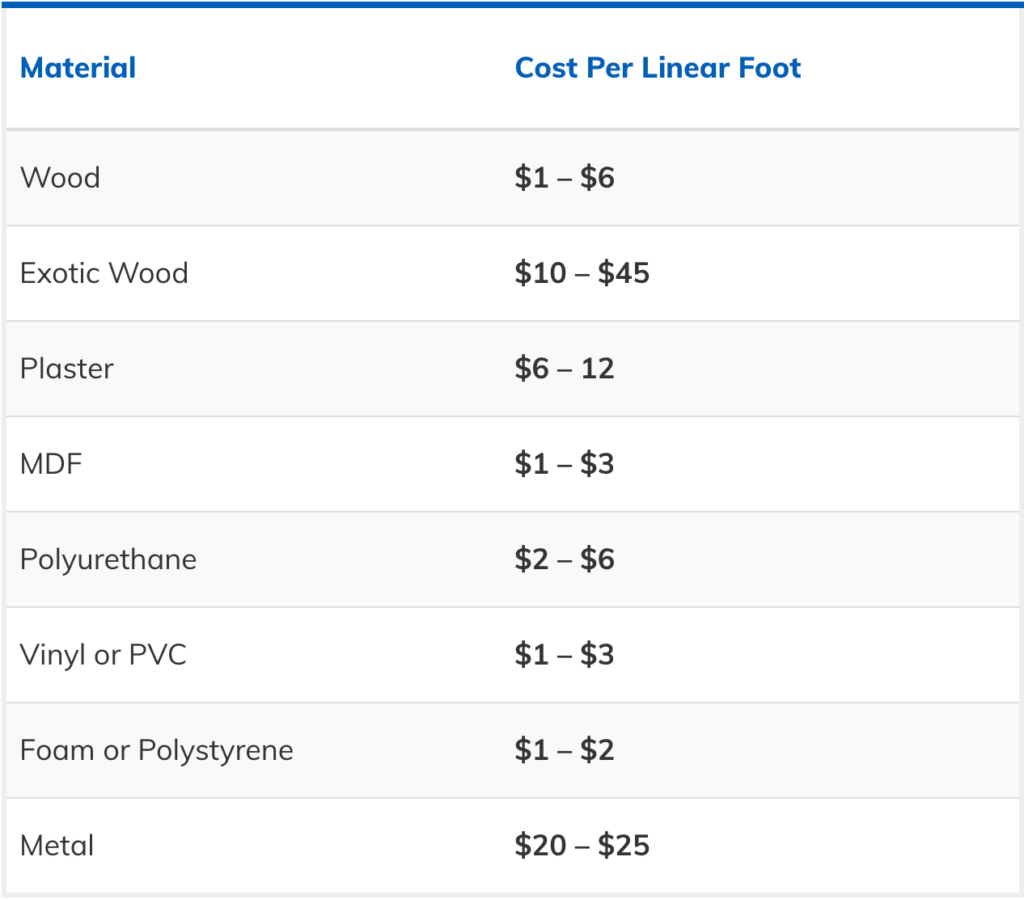
How Much Is Crown Molding – By Material?
Remember that the type of material can be subject to other costs – such as priming and painting to achieve the finished look.
Please note: there are links to products for purchase. I will get a small commission if you purchase an item from one of the links. It helps towards maintaining the cost of this site so thanks very much!
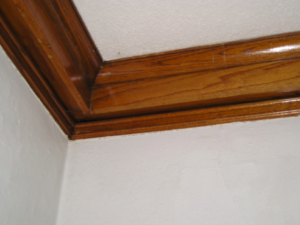 Wood Crown Molding
Wood Crown Molding
When it comes to wood crown molding, the costs can vary quite a bit. As a general guide, I’ve seen walnut, ash and knotty pine sell between $1 and $6 per linear foot and more exotic, the more cost. For example, white and red oak, mahogany, hickory and quarter-sawn oak can range from $10 to $45 per linear foot.
Should mention that the benefit of more expensive material means it won’t warp or crack and it’s easier to carve more intricate designs into it. The softer the wood, the easier the carving job is. You can also buy it pre-stained or painted and some even get their other wood furnishings in their home to match.
What are the advantages of wood crown molding?
- Natural wood is a traditional material that is hard to imitate and the hardwoods like oak and mahogany stain beautifully. Color and grain patterns really add warmth to a room.
- It’s available in a variety of stock profiles with more ornate reliefs completed by embossing wood composites onto solid wood.
What are the drawbacks to wood crown molding?
- Solid wood molding pieces often are not primed.
- You need to pay careful attention to the installation process as it requires exact angle cuts and can vex the most skilled carpenter
- Material can shrink and swell depending on changes in the weather
What is wood crown molding best for?
- A good all rounder suitable for most applications
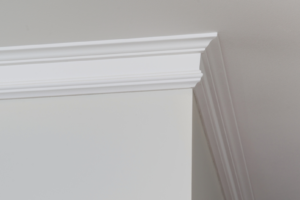
Plaster Crown Molding
Plaster really allows homeowners are a wide range of design options. Roman dental and English vine styles are quite popular. Pricing varies between $6 and $12 per linear foot and the upside is that plaster doesn’t react to moisture by warping or shrinking the same way that wood does.
What are the advantages of plaster crown molding?
- Looks amazing in elaborate profiles and some of which cannot be milled out of wood.
- It won’t shrink or warp.
What are the drawbacks to plaster crown molding?
- It can be quite heavy so we recommend installing it with a mate plus you want to support it properly as it can crack during installation.
- As it’s custom made, it can become quite expensive and there’s no such thing as ‘off-the-shelf’ here. Plus it can be tricky to install.
What is wood crown molding best for?
- A grand interior with high ceilings and typically with a plaster wall (it’s best if it’s buttered on the back with fresh plaster for installation). You’ll need a budget to match it’s high style.
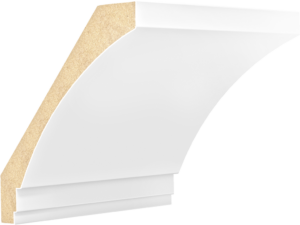
MDF Crown Molding
MDF (medium-density fibreboard) crown molding is down the lower end in price with cost ranging from $1 to $3 per linear foot. Hence it’s much more economical than wood. It’s also light and an easy DIY job for one person and you can paint it nicely too.
What are the advantages of MDF crown molding?
- As a composite material (made from sawdust and resins) MDF is stable, low cost and available in a large range of stock profiles – some with a natural wood veneer suitable for staining.
What are the drawbacks to MDF crown molding?
- As it’s soft, it can dent or nick easily during installation
- Without veners, MDR must be painted
- MDF can warp in rooms with high humidity
What is MDF crown molding best for?
- Rooms where trim is painted
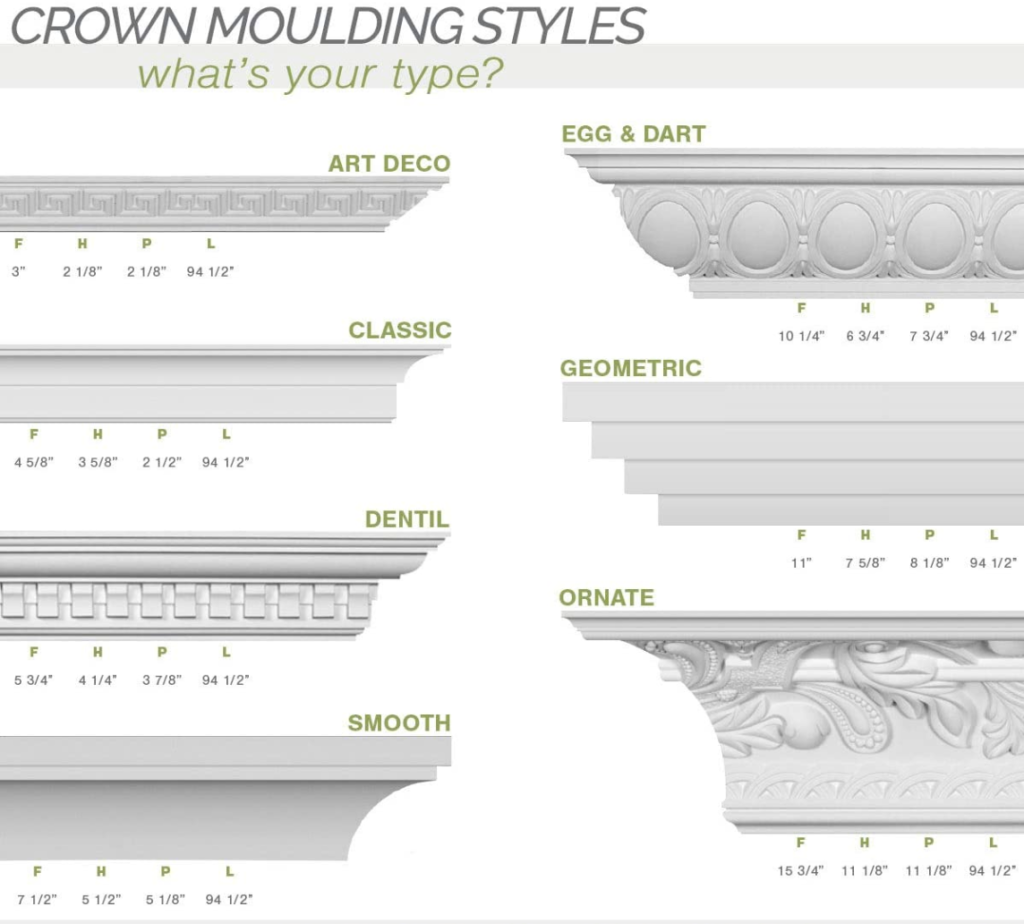 Polyurethane Crown Molding
Polyurethane Crown Molding
Polyurethane molding is made from very dense foam and is similar to wood but much lighter in weight. It’s another cost friendly choice ranging from $2 to $6 per linear foot on average. Another bonus is that it doesn’t react to moisture and bugs aren’t interested in it either! You buy it pre-primed, ready for paint.
What are the advantages of polyurethane crown molding?
- Less expensive and more stable than wood
- Also more rot and insect repellent than wood
- An excellent wood imitation
- Mills and cuts like pine and goes up with the same nails (takes paint equally well)
- Available in elaborate, plasterlike profiles
What are the drawbacks to polyurenthane crown molding?
- Like MDF, polyurethane can dent easily and it must be painted.
What is polyurethane crown molding best for?
- This product works in most installations
What polyurethane crown molding product do you recommend?

We Recommend the Ekena Millwork MLD02X02X03JE-CASE-12 Jefferson Traditional Smooth Crown Moulding (12-Pack)
If you’re interested in polyurenthane crown molding, this product by Ekena Millwork is well worth checking out. It comes in packs of various sizes with the 8 pack covering around 60 feet.
One of the upside to this approach, is that you can buy corner blocks for it so you won’t need to drag out the miter saw to make some.
It is designed to use with glue (we recommend a polyurethane based construction adhesive like PL premium or Powergrab, but you can cut one length about 1/8” longer for a tight scarf joint fit to reduce this need.
It’s light weight and easy to install with the use of a finish nailer. Like all polyurethane products, it does need to be painted – but you can opt for a faux finish, gel stain or even marbleizing.
Honestly, you won’t be able to tell it’s not wood but is the fraction of the cost. It also holds up well in bathrooms and other high humidity areas where wood tends to warp.
To check the price on the Ekena Millwork MLD02X02X03JE-CASE-12 Jefferson Traditional Smooth Crown Moulding (12-Pack), click here.
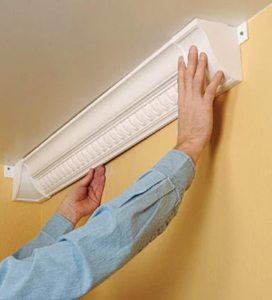
Vinyl or PVC Crown Molding
Generally vinyl or PVC crown molding ranges in price from $1 to $3 per linear foot. Known for being durable, strong and reliable, vinyl is a great choice for crown molding. It’s easy to cut and installs without chipping or breaking. Another advantage is that vinyl can be used on both indoors and outdoors making it a practical option in bathrooms and kitchens as it does not absorb moisture. Also useful for hiding cables and rope lighting too!
What are the advantages of vinyl or PVC crown molding?
- The plastic polymers in this product won’t warp or rot, no matter how wet it gets
- Cost effective
What are the drawbacks to vinyl or PVC crown molding?
- It’s known to be brittle and can crack during installation when nail holes are drilled into it.
- It’s not flexible.
- Can be tricky to paint (as it’s slick surface is difficult to paint neatly) bgut it needs painting in order to cover the plastic sheen.
- Style options and colors are limited and precludes ornate designs altogether.
What are vinyl or PVC crown molding best for?
- Bathrooms, exteriors or anywhere moisture is a concern and a simple profile is appropriate
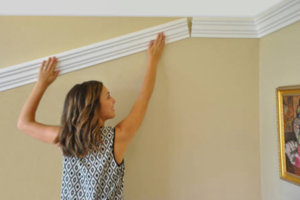
Polystyrene or Foam Crown Molding
At only $1 to $2 per linear foot, polystyrene foam in the least expensive crown molding you can buy. It is made from high density Styrofoam and topped with a fiberglass and acrylic plaster. It’s easy to installed with joint compound or construction adhesive and even a kitchen knife can cut right through it. It’s also slightly flexible making it a good choice if your wall is not exactly straight.
What are the advantages of polystyrene crown molding?
- Low cost plus it’s light and easy to install (perfect for even the less than skilled installer!)
- Goes up with construction adhesive and can be cut with scissors.
What are the drawbacks to polyurenthane crown molding?
- Is subject to off-gassing and gives off toxic fumes when cut.
- It will crack in homes with structural shifting issues.
- Foam molding dents easily.
- It will need to be painted.
- The closer you get, the more you’ll see it’s takeout-coffee cup texture and less than crisp edges.
What is polystyrene crown molding best for?
- A quick room dress up
What polystyrene crown molding product do you recommend?

We recommend, 64 Ft of 3.5″ Angelo Foam Crown Molding Room kit W/precut Corners on end of Lengths 4 Inside & 1 Out by Austin Crown Molding. It is great for indirect or LED lighting. It’s super simple and fast to put up and cuts easily and neatly.
Since the material lays flat on the saw, all you need to do is set the table to 90 degrees and bevel to 45 degrees. It’s pretty straight forward but works best if your walls are regular and corners are true.
It is a cost effective option and is best for a quick room dress up, rather than something that is designed to last the distance. Not sure how it would fair in the long run with weather changes. It will need to be painted too.
It’s light weight and can be fitted and looking good in no time at all.
To check out the price of theAngelo Foam Crown Molding Room kit W/precut Corners on end of Lengths 4 Inside & 1 Out by Austin Crown Molding, click here.
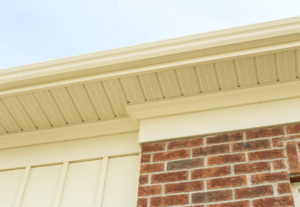
Aluminum, Copper and Steel Molding
On the pricier end, metal crown molding such as aluminium, steel or copper molding costs between $20 and $25 per linear foot. Metal molding is used mostly for outdoor areas as well as garages, or metal hoods in kitchens. It’s durable and metal molding can come with pre-formed inside and outside corner pieces, negating the need for miter cuts.
What are the advantages of aluminium, copper and steel crown molding?
- Exterior metal crown moldings can be custom applied to eaves, gable ends, rakes, frieze boards and dormers.
- Trim can be formed to look like colonial wood crown molding.
- Profiles can have a seamless length or 12 ft.
- You can install with blind nailing to eliminate the sight of nails.
What are the drawbacks to aluminium, copper and steel crown molding?
- Must be cut with a steel-cutting saw like a miter saw, to create angle corners correctly.
- Copper weathers to form a green patina if installed outdoors.
- Steel can rust in areas of high humidity.
- Aluminum can crack in extreme climates.
What are aluminium, copper and steel crown molding best for?
- Best for outdoor applications as it’s designed to weather the elements and are virtually maintenance free.
Tools Needed to Install Crown Molding
Besides the crown molding material, the other costs associated with the installation is of course the tools and equipment needed to get the job done.
- Miter Saw: click here to read our review guide, ‘What To Look For When Buying A Miter Saw.’ Or if you’re just getting started, you may want to check out our post, ‘What Are Miter Saws Used For?’
- Coping Saw
- Finish Nail Gun: click here to read our review guide, ‘What is the Best Cordless Finish Nailer (including crown molding)?‘
- Caulking Gun
- Nails
- Measuring tape
- Spirit Level
- Chalk Line
